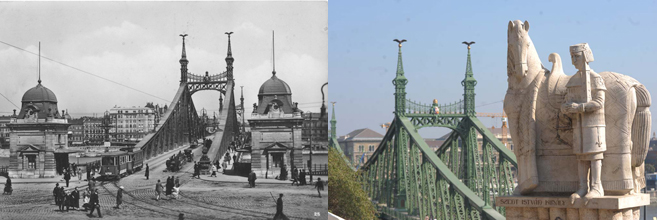1/8
Széchenyi Lánchíd
Széchenyi Lánchíd () is arguably the most mesmerizing bridge in Budapest, and one of the city’s symbols. Its bewitching beauty is not the only reason we’ve decided to put it on the mountaintop of Budapest’s bridges; for the history of Lánchíd is just as rich as its ornaments. Before commencing a lesson about the past, let us take a glance at the facts of the present. On the Pest side, facing illustrious , Lánchíd is anchored to Széchenyi tér (Széchenyi Square). On the Buda side, it’s anchored to Clark Ádám tér, where the grants an instant access to the Royal Palace. As for Lánchíd’s history, it was the first bridge in Budapest, designed by William Tierney Clark to the initiative of Count István Széchenyi. The construction was supervised by Adam Clark, and was funded by a Greek merchant, Georgios Sinas. Lánchíd was opened to the public in 1849, and became an international sensation within a blink of an eye. The siege of Budapest had taken its toll on Lánchíd, but after the storms of World War II drifted away, it was rebuilt and reopened in 1949.
2/8
Erzsébet híd
Erzsébet híd () was named after Queen Elizabeth, the beloved empress of the Austro-Hungarian monarchy assassinated in 1898. During the time of its construction – it was opened to the public in 1903 -, the original suspension bridge was an engineering miracle that raised eyebrows all over the globe. Unfortunately, retreating Wermacht troops blew up the first version of Erzsébet híd in 1945, and deprived us of the chance to witness its impressive glory. Two decades later, between 1961 and 1964, it was rebuilt according to the plans of Pál Sávoly, and required minor tweaks throughout the following decades. The spectacular floodlights projecting the tri-colours of the Hungarian flag on Erzsébet híd’s pillars were a present from the Japanese state in 2009, and were a creation of Isii Motoko. As for the usual data, on the Pest side, it is anchored to Március 15. tér (March 15 Square), granting an easy access to Váci utca () and . On the Buda side, it is anchored at the the winding staircases leading up to Gellért-hegy (Gellért Hill) and Citadella (The Citadel).
3/8
Szabadság híd
Szabadság híd (), the third oldest bridge in Budapest was built between 1894 and 1896, and was originally named after Emperor Franz Joseph. The construction, which was funded from the tolls collected on Budapest’s other bridges, was executed according to the plans of János Feketeházy, although other engineers – István Gállik, József Beke, Virgil Nagy – also took part in the process. And now comes the expected sad part of the story: Szabadság híd was blown up in 1945 by retreating Wermacht troops. To sugarcoat the bitter reality, it was rebuilt and reopened a year later, but, due to a lack of paint, it only regained its birch-green colour in 1984. Between August 2007 and December 2008, Szabadság híd was wholly renovated for 5.6 billion HUF, and became a rival of both Lánchíd with its renewed vintage glory. On the Pest side, it is anchored to Fővám tér, and neighbours both Központi Vásárcsarnok () and Corvinus University. On the Buda side, it’s anchored to Szent Gellért tér, a square famous for Budapest’s most well-known historic bath, .
4/8
Margit híd
Margit híd (Margaret Bridge), the second oldest bridge in Budapest, was built between 1872 and 1876 according to the plans of French engineer Ernest Gouüin. Just like all the other bridges, it was blown up in January 1945, but was already damaged at the time due to an accidental mine explosion that took place in 1944 and killed hundreds of citizens and dozens of soldiers. The rebuilding process reached its end in 1948, and further changes were made during the 1970s. At the end of the previous decade, the conditions of Margít híd’s certain elements were deemed life threatening, so a thorough renovation couldn’t have been postponed any further. The works began in 2009, ended in June 2011, and had a total cost of 20 billion HUF. Regarding the location of Margit híd, on the Pest side, it’s anchored to Jászai Mari tér, a stone’s throw away from both the and the most picturesque parts of the Danube Promenade. On the Buda side, it’s anchored to Germanus Gyula park, near historic baths such as and , and the most eastern Islamic sanctuary in the world, Gül Baba’s tomb. Moreover, the bridge grants an access to Margitsziget (), with its two parts enclosing 165 degrees at the island’s entrance.












